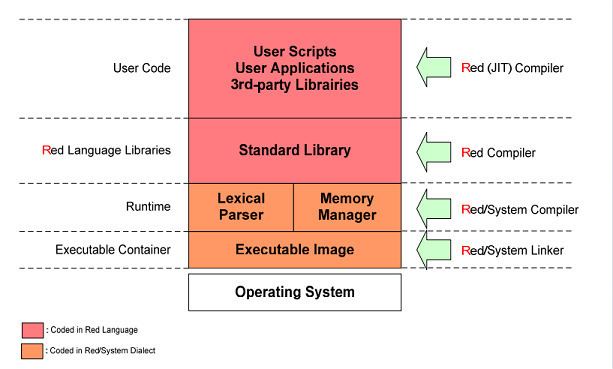Designed by Nenad Rakocevic First appeared 2011 | Developer Nenad Rakocevic | |
 | ||
Stable release 0.6.1 (Alpha) / July, 2016 | ||
Red is a computer programming language. Red was made to overcome the limitations of the programming language Rebol. Introduced in 2011 by Nenad Rakocevic, Red is both an imperative and functional programming language. Its syntax and general usage overlaps that of the interpreted Rebol language (which was introduced in 1997).
Contents
The implementation choices of Red intend to create a full stack programming language: Red can be used for extremely high-level programming (DSLs and GUIs) as well as low-level programming (operating systems and device drivers). Key to the approach is that the language has two parts: Red/System and Red.
if x > y [print "Hello"] instead of if (x > y) {printf("Hello");}.Red seeks to remain independent of any other toolchain; it does its own code generation. It is therefore possible to cross-compile Red programs from any platform it supports to any other, via a command-line switch. Both Red and Red/System are distributed as open-source software under the modified BSD license. The runtime library is distributed under the more permissive Boost Software License.
Introduction
Red was introduced in the Netherlands on February 2011 at the Rebol & Boron conference by its author Nenad Rakocevic. In September 2011, the Red programming language was presented to a larger audience during the Software Freedom Day 2011. Rakocevic is a long-time Rebol developer known as the creator of the Cheyenne HTTP server; he was the joint winner of the "Rebol of the Year" 2011 election.
Features
Red's syntax and semantics are very close to those of Rebol. Like Rebol, it strongly supports metaprogramming and domain-specific languages (DSLs) and is therefore a highly efficient tool for dialecting. Red builds on a dialect called Red/System, which provides system programming facilities. Red is easy to embed ("Think Lua") and very lightweight (no more than a megabyte). It is also able to cross-compile to various platforms (see Cross Compilation section below) as well as creating packages (like .APK packages on Android) for some platforms (currently, Android is the only platform supported but development is still in process) via bridges intended for implementation of Red on the former (like the Java JVM, .NET, JavaScript etc).
Goals
The following is the list of Red's Goals as presented on the Software Freedom Day 2011:
Development
Red's development is planned to be done in two phases:
- Initial phase: Red and Red/System compilers written in Rebol 2
- Bootstrap phase: Red and Red/System compilers complemented by a Red JIT-compiler, all written in Red
Cross compilation
Red currently supports the following cross-compilation targets:
(Note: This list will increase with time and should therefore be considered as incomplete.)
Factorial Example
The following is a factorial example in Red :
The following is the same factorial example in Red/System (in this very simple case, the source code is very similar to Red's version) :
